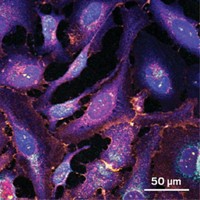Advertisement
Grab your lab coat. Let's get started
Welcome!
Welcome!
Create an account below to get 6 C&EN articles per month, receive newsletters and more - all free.
It seems this is your first time logging in online. Please enter the following information to continue.
As an ACS member you automatically get access to this site. All we need is few more details to create your reading experience.
Not you? Sign in with a different account.
Not you? Sign in with a different account.
ERROR 1
ERROR 1
ERROR 2
ERROR 2
ERROR 2
ERROR 2
ERROR 2
Password and Confirm password must match.
If you have an ACS member number, please enter it here so we can link this account to your membership. (optional)
ERROR 2
ACS values your privacy. By submitting your information, you are gaining access to C&EN and subscribing to our weekly newsletter. We use the information you provide to make your reading experience better, and we will never sell your data to third party members.
Analytical Chemistry
Seeing Molecules Change Shape
New technique makes it possible to analyze picosecond molecular dynamics
by Stu Borman
May 19, 2008
| A version of this story appeared in
Volume 86, Issue 20
A faster, more powerful way to observe molecular shape changes over time has been developed by a team of spectroscopists.
The microwave spectroscopy technique, devised by Brooks H. Pate and coworkers at the University of Virginia, Charlottesville, and reported in Science (2008, 320, 924), should be applicable to studies of reaction dynamics in "radical intermediates, molecular complexes, and conformationally flexible molecules of biological interest," the researchers note. Such reactions are currently difficult or impossible to observe experimentally by any other way.
Scientists can use the technique to measure rates of molecular processes "on very rapid time scales with unprecedented detail and precision," comment molecular spectroscopists Dmitry G. Melnik and Terry A. Miller of Ohio State University, Columbus, in the same issue of Science. "The work may substantially advance understanding of why the products of some chemical reactions depend strongly on the molecular shapes of the reactants."
Microwave spectroscopy measures rotations of small molecules in the gas phase and can be used to determine molecular structure. Fourier transform (FT) data analysis methods have enhanced the sensitivity and resolution of the technique. Microwave spectroscopy can also potentially be used to follow conformational changes induced by laser excitation. But the technique's slow spectral acquisition time has made it impractical for analyzing laser-excited species in the past.
Pate and coworkers' new chirped-pulse FT microwave method (CP-FTMW) changes the game. It uses a microwave pulse covering a wide range of frequencies to greatly improve spectral acquisition times. The method achieves speed enhancements of two to four orders of magnitude over conventional microwave spectroscopy, making it suitable for analyzing excited-state molecular reactions on a picosecond time scale.
CP-FTMW could "revolutionize microwave spectroscopy and its applications," says molecular spectroscopist Wolfgang Jäger of the University of Alberta, Edmonton. For example, it could open a window to a better understanding of the role of solvent molecules in isomerizations, he says.
The new technique is "a significant and exciting extension of microwave spectroscopy," says FT microwave specialist Sean A. Peebles of Eastern Illinois University, Charleston. "The considerable reduction in the time required for the measurement of rotational spectra using the technique makes it possible to provide high-quality experimental data on dynamic processes that challenge current theory," he says.
Pate and coworkers used CP-FTMW to measure the rate of a syn-to-anti conformational change that occurs when an infrared laser hits cyclopropane carboxaldehyde with a range of excitation frequencies. The technique revealed that the transition occurs 16 times more slowly than had previously been estimated theoretically.
To scan through the varying laser excitation frequencies, Pate and coworkers needed to quickly measure an 11-GHz span (7.5 to 18.5 GHz) of cyclopropane carboxaldehyde's rotational spectrum at each frequency. "Using previous technology, that would take 14 hours," Pate says, but CP-FTMW does it in 10 seconds. "This factor-of-5,000 improvement at each excitation energy is the key to making the method work."
Pate now hopes to develop CP-FTMW for other applications, such as detecting low-level chemical warfare agents in air. His group is also working on a version of a CP-FTMW instrument "that is less expensive, more compact, and doesn't require vacuum pumps," he says.




Join the conversation
Contact the reporter
Submit a Letter to the Editor for publication
Engage with us on Twitter